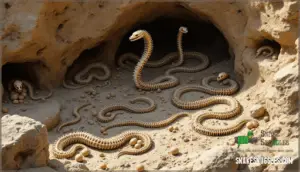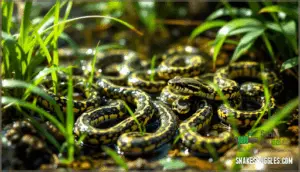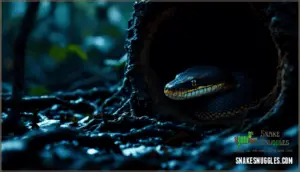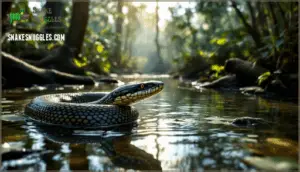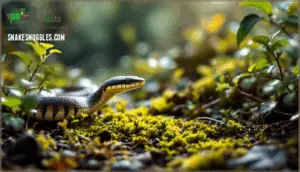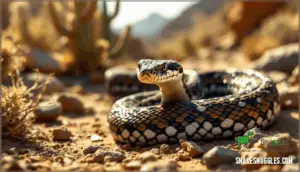This site is supported by our readers. We may earn a commission, at no cost to you, if you purchase through links.

This reproductive strategy isn’t just a quirky evolutionary footnote. It’s an adaptation that allows certain snakes to thrive in environments where exposed eggs would freeze, desiccate, or become predator snacks.
From the cold-climate garter snakes of North America to the massive anacondas of South American rivers, live-bearing species have carved out ecological niches their egg-laying cousins can’t touch. Understanding how and why these snakes evolved this method reveals fascinating insights into reptilian survival strategies.
Table Of Contents
- Key Takeaways
- Snakes That Give Live Birth
- How Do Snakes Reproduce?
- Snakes With Unique Reproduction
- The Evolution of Live-Bearing Snakes
- What is The Largest Snake Ever Found?
- Snakes That Give Birth to Live Young
- Why Do Some Snakes Give Birth to Live Young?
- Frequently Asked Questions (FAQs)
- Do snakes give birth to live young?
- How to identify when a snake has finished giving birth?
- Which snakes give live birth?
- Do snakes give birth or lay eggs?
- What kind of snakes give live birth?
- Do copperheads give live births?
- Do cottonmouths give live birth?
- What snakes in the United States lay eggs?
- Do copperheads give live birth?
- What snakes can have babies without mating?
- Conclusion
Key Takeaways
- Roughly 20% of snake species give live birth instead of laying eggs, using either viviparous reproduction (with placental nourishment) or ovoviviparous reproduction (retaining eggs internally until hatching), which protects developing offspring in cold climates, aquatic environments, and predator-heavy zones where exposed eggs would fail.
- Live-bearing snakes like garter snakes, boas, rattlesnakes, and anacondas evolved this strategy independently at least 115 times across reptilian history, demonstrating that the ancestral state of snakes may have actually involved live birth rather than egg-laying.
- Species that give live birth show remarkable adaptations including sperm storage for years (garter snakes), gestation periods of 3-8 months depending on species, and the ability to thrive in habitats ranging from frozen Canadian prairies to open ocean waters where egg-layers simply can’t survive.
- The shift to live birth represents a direct evolutionary response to environmental pressures, offering advantages like protection from temperature extremes, reduced predation during development, enhanced parental investment, and significantly higher offspring survival rates in challenging ecosystems.
Snakes That Give Live Birth
While most snakes lay eggs and leave them to hatch on their own, a surprising number of species have evolved a different approach—giving birth to fully formed, live young. This reproductive strategy, seen in viviparous and ovoviviparous snakes, offers distinct viviparity advantages for survival. Live birth protects developing offspring from predators and harsh environmental conditions that would threaten exposed eggs.
Species like garter snakes, boa constrictors, and anacondas have adapted this method across diverse geographic distributions, from temperate wetlands to tropical rainforests. Gestation periods vary considerably—boas carry their young for 100-150 days, while anacondas nurture embryos for several months before delivering broods of up to 30 young.
Some livebearing snakes even exhibit striking maternal care adaptations, with garter snakes storing sperm for years to refine reproductive timing. This placental evolution in certain species represents nature’s solution to maximizing offspring survival in challenging habitats.
How Do Snakes Reproduce?
Regarding reproduction, snakes don’t all follow the same playbook. You’ll find three main strategies these reptiles use to bring their young into the world, each with distinct advantages.
Let’s look at how oviparous, viviparous, and ovoviviparous reproduction work in different snake species.
Oviparous
If you’ve ever stumbled across a clutch of leathery eggs tucked beneath a log or inside a burrow, you’ve likely found the handiwork of an oviparous snake. These egg-laying snakes deposit their clutches and leave the developing embryos to incubate on their own. Oviparity dominates the snake world, with most species relying on this strategy.
Key characteristics of oviparous snakes:
- Clutch size varies widely—from just a few eggs to over 100, depending on the species
- Eggshell composition features a leathery, parchment-like texture that absorbs moisture from the environment
- Parental care is minimal; most egg-laying snake species provide no protection once eggs are deposited
Hatchlings emerge fully formed and ready to hunt.
Viviparous
Unlike those egg-layers that walk away from their clutches, viviparous snakes take a different approach—they carry their developing young inside their bodies until they’re ready to be born. This viviparity involves genuine placental development, where embryos receive oxygen and nutrients directly from the mother’s bloodstream.
You’ll find this maternal investment in boas, rattlesnakes, and anacondas, where gestation length usually spans 3-6 months depending on species and environmental conditions.
The evolution of live birth improves offspring survival, especially in colder climates where eggs would freeze, making livebearing snakes remarkably adaptable across diverse habitats.
Ovoviviparous
While viviparous snakes nourish their young directly through a placenta, ovoviviparous snakes take a fascinating middle road. These species retain eggs internally until hatching occurs, usually moments before birth. This egg retention strategy offers evolutionary advantages by protecting developing embryos from predators and environmental extremes while requiring less maternal investment than true viviparity.
Here’s how ovoviviparous reproduction works:
- Nutrient provision comes entirely from yolk sacs, not maternal bloodstreams
- Birth frequency varies from annual to biennial depending on species and climate
- Geographic distribution spans cold-climate zones where external eggs would freeze
- Young emerge fully formed and independent immediately after birth
You’ll find this snake reproduction method in garter snakes, death adders, and some sea snakes. The evolution of live birth through ovoviviparity represents nature’s compromise—combining egg-laying efficiency with livebearing protection for maximum offspring survival.
Snakes With Unique Reproduction
While most snakes stick to traditional egg-laying or straightforward live birth, a few species have taken reproductive strategies in unexpected directions. You’ll find adaptations here that blur the lines between typical methods, shaped by specific environmental pressures.
Let’s look at three snakes that stand out for their distinctive approaches to bringing young into the world.
Rinkhals
The Rinkhals stands apart from its cobra cousins with a fascinating twist — it gives birth to live young instead of laying eggs. This ovoviviparous snake develops 20-35 babies internally before they emerge fully formed and ready to defend themselves.
Found across southern Africa’s grasslands and savannas, the Rinkhals behavior includes an impressive defensive tactic: spraying venom up to 8 feet when threatened. Despite this fierce reputation, these snakes are surprisingly shy.
Their Rinkhals diet consists mainly of toads and small rodents, making them valuable for pest control throughout their Rinkhals distribution range in southern African habitats.
Sea Snakes
Most sea snakes never touch solid ground—they’ve evolved to give birth in open water, delivering live young that can swim from their first breath. These viviparous reptiles showcase exceptional marine adaptation through specialized aquatic adaptations that support their entirely oceanic lifestyle. Their venom potency ranks among the highest of all snakes, yet their docile nature and small fangs reduce danger to humans.
Key features of sea snake reproduction and survival include:
- Salt regulation through specialized glands that excrete excess salt
- Diving behavior allowing submersion for up to two hours between breaths
- Live birth of 2-9 fully independent young after 4-11 month gestation
- Conservation status ranging from least concern to critically endangered depending on species
Water Snakes
Freshwater snakes have quietly mastered one of nature’s trickiest balancing acts—thriving in rivers and ponds where most reptiles would struggle to survive. These viviparous aquatic snakes demonstrate striking aquatic adaptations, from flattened bodies for efficient swimming to specialized scales that reduce water resistance.
You’ll find them exhibiting impressive habitat diversity across North America, with regional variations in size and behavior. Their predatory behavior focuses on fish and amphibians, which they track through murky water using chemical detection.
Water snakes give live birth to 10-30 young in late summer, showcasing one of the most efficient snake reproduction methods in freshwater ecosystems. Conservation status varies by species and location.
The Evolution of Live-Bearing Snakes
Live birth in snakes isn’t just a modern trick—it’s an ancient survival strategy stretching back 175 million years. Scientists now believe the ancestral state of all snakes and lizards involved giving birth to live young, not laying eggs. This challenges what we thought we knew about snake reproduction methods.
Live birth in snakes is an ancient survival strategy dating back 175 million years, challenging our assumptions about reptilian reproduction
Evolution of live birth happened through multiple origins rather than a single event. Notably, reptiles evolved viviparity at least 115 times. Here’s how evolutionary pressures shaped this adaptation:
- Climate adaptation: Cold environments drove the shift to viviparity, since internal incubation protects developing embryos from freezing temperatures that would kill eggs
- Genetic variations: Species switched between egg-laying and live birth dozens of times throughout history, showing striking flexibility
- Dual strategies: Viviparous snakes nourish young through placental structures, while ovoviviparous snakes retain eggs internally until hatching
These reproductive innovations gave certain lineages distinct advantages in challenging habitats where traditional egg-laying would fail.
What is The Largest Snake Ever Found?
When you picture the world’s most colossal serpent, you’re probably thinking too small—fossilized remains from 47 million years ago reveal a snake so enormous it makes today’s anacondas look like earthworms. Named Vasuki indicus after the mythical Hindu serpent deity, this prehistoric giant stretched between 11-15 meters long, potentially outmeasuring even Titanoboa. The fossil discovery in Gujarat, India, gives you a glimpse into ancient ecosystems where such massive predators thrived in warm, swampy environments.
Here’s what sets Vasuki apart in snake evolution:
- Exceeded modern anacondas by nearly double their maximum length
- Weighed an estimated 1,000+ kilograms based on vertebral dimensions
- Dominated tropical wetlands during the Eocene epoch’s greenhouse climate
For perspective, today’s largest reticulated pythons max out around 10 meters. Prehistoric size like this reveals how Earth’s warmer past supported snake species we can barely imagine now.
Snakes That Give Birth to Live Young
Now that you understand the different ways snakes reproduce, let’s look at specific species that give birth to live young. You’ll find that these snakes come from diverse families and habitats, each with its own fascinating approach to bringing new life into the world.
Here are six notable examples of live-bearing snakes you might encounter.
Garter Snakes
If you’ve ever wondered which snake species bring their babies into the world fully formed and ready to slither, garter snakes top the list with an impressive range of 4 to 80 live young per litter.
These Natricines thrive across diverse habitats—from wetlands to woodlands—and possess mild venom through specialized Duvernoy’s glands. What’s striking is their sperm storage capability, allowing females to delay fertilization for optimal conditions.
| Characteristic | Details |
|---|---|
| Reproduction | Viviparous; delivers 4-80 live young |
| Diet | Small amphibians, fish, earthworms |
| Habitat Range | Wetlands, forests, grasslands across North America |
Boa Constrictors
Boa constrictors exemplify ovoviviparous snake reproduction through their significant maternal investment. During the dry season, females undergo internal fertilization and carry embryos for approximately 5-8 months—averaging 105 days after their post-ovulatory shed. Throughout this gestation length, mothers provide vital thermoregulation and protection.
Litter size varies considerably, ranging from 10 to 64 young, with most producing around 25 neonates. These fully independent babies measure 38-51 cm at birth. Notably, mating behaviors include polygynandrous systems where both sexes have multiple partners, and females can store sperm for up to a year.
In captivity, reproductive tech like ultrasonography monitors embryonic development, while rare parthenogenesis cases demonstrate asexual live birth capabilities in this viviparous snake species. They also play a role as valued pest controllers in tropical America.
Anacondas
Anacondas, one of the largest viviparous snake species, are dominant predators lurking in South America’s rainforests and wetlands. You’ll find them coiled in shallow waters, using their muscular bodies to ambush prey. These impressive constrictors are masters of their environment, combining anaconda size with striking agility.
Their anaconda behavior centers on patience—they’ll wait motionless for hours before striking. Unlike boa constrictors that climb trees, anacondas prefer aquatic habitats where they hunt efficiently.
- Anaconda habitat: Swamps, slow-moving rivers, dense flooded forests
- Anaconda diet: Capybaras, caimans, fish, occasionally deer
- Live birth advantage: Females deliver 20-40 fully developed young
- Anaconda conservation: Threatened by habitat destruction and illegal hunting
Their viviparous snake reproduction guarantees offspring survive South America’s challenging wetlands.
White-lipped Snakes
While anacondas rely on sheer size to dominate their wetlands, the white-lipped snake proves you don’t need bulk to survive—just the right reproductive strategy for your climate. These viviparous snakes thrive in Australia’s cooler regions, where live birth protects developing young from freezing temperatures that would kill eggs.
You’ll find white-lipped snakes in moist habitats like coastal heathlands and forest edges, hunting small skinks and frogs. Their mild venom immobilizes prey quickly, though they’re generally non-aggressive toward humans.
As livebearing snake species go, they’re excellent examples of adaptation—trading the egg-laying approach for internal development that suits their environment perfectly.
Rattlesnakes
Rattlesnakes, notorious for their trademark warning sound and potent venom, represent some of the most successful viviparous snakes across North America’s varied landscapes. These livebearing snakes develop their young internally for 4-5 months before giving birth to 10-20 fully formed offspring.
You’ll encounter diamondback variations in diverse rattlesnake habitats, from Sonoran deserts to Appalachian forests, where their rattlesnake behavior balances defensive caution with efficient hunting.
Rattlesnake venom immobilizes prey quickly, though conservation efforts now protect these misunderstood predators from habitat loss and persecution.
Amazon Tree Boa
Deep in the Amazon rainforest’s emerald canopy, the Amazon Tree Boa coils around branches with the precision of an acrobat, showcasing nature’s mastery of arboreal adaptation.
This viviparous snake gives live birth to 5-20 young after several months of gestation, skipping the vulnerable egg stage entirely. You’ll find stunning color morphs ranging from yellow to deep orange, each perfectly camouflaged for their treetop world.
Their dietary habits focus on birds, bats, and small mammals, which they ambush with heat-sensing pits. Though temperament varies, most remain defensive when threatened, relying on their grip strength rather than constriction like their boa constrictor relatives.
Why Do Some Snakes Give Birth to Live Young?
Why do certain snake species favor live birth over laying eggs? The answer lies in environmental pressures and evolutionary drivers that make internal development a winning strategy.
Climatic adaptation plays a significant role—in cold regions where eggs might freeze or fail to incubate properly, viviparous snakes keep embryos warm inside their bodies. Ovoviviparous species, like garter snakes, also benefit from this protective approach. Live birth offers several reproductive advantages:
- Protection from temperature extremes that would damage exposed eggs
- Reduced predation risk during the vulnerable developmental stage
- Ability to inhabit aquatic environments where egg-laying proves impractical
- Enhanced parental investment through internal nourishment and development
- Greater offspring survival rates in challenging habitats
These benefits of live birth explain why approximately 20-30% of snake species evolved this strategy. Snake reproduction strategies reflect nature’s striking adaptability—viviparous snakes like boas and rattlesnakes thrive in environments where egg-layers simply can’t compete.
Frequently Asked Questions (FAQs)
Do snakes give birth to live young?
Yes, certain species deliver live young instead of laying eggs. Boa constrictors, garter snakes, and rattlesnakes are viviparous or ovoviviparous snakes that give live birth. This adaptation helps their offspring survive harsh climates and evade predators immediately.
How to identify when a snake has finished giving birth?
You’ll notice physical changes when your snake finishes giving live birth. Her belly becomes noticeably flatter, and she’ll stop straining or contracting.
Count the newborns carefully—once all offspring are delivered and moving independently, the birthing process is complete.
Which snakes give live birth?
Several snake families feature livebearing snakes. Boas and rattlesnakes are viviparous, nourishing young through placental connections. Garter snakes and anacondas are ovoviviparous, developing eggs internally before giving live birth.
These snake reproduction methods evolved to boost snakelet development and survival in challenging habitats.
Do snakes give birth or lay eggs?
Both strategies exist in the snake world. Oviparous species lay eggs, while viviparous and ovoviviparous snakes give live birth.
These reproductive strategies reflect evolutionary advantages: livebearing snakes thrive in colder climates where eggs might freeze, showcasing striking snake diversity across environments.
What kind of snakes give live birth?
You’ll find viviparous species like boas and rattlesnakes, plus ovoviviparous ones like garter snakes and sea snakes.
These live-bearing snakes evolved this adaptation to thrive where eggs wouldn’t survive—cold climates, aquatic environments, or predator-heavy zones.
Do copperheads give live births?
Copperheads are ovoviviparous, which means their eggs develop inside the mother’s body.
You’ll see live young emerge, usually between late summer and early fall, with litters ranging from three to ten snakelets depending on the female’s size and regional conditions.
Do cottonmouths give live birth?
Cottonmouths are viviparous pit vipers that give live birth, usually delivering 6-12 offspring in late summer.
This adaptation helps their young survive in swampy wetlands where egg-laying would leave them vulnerable to flooding and aquatic predators.
What snakes in the United States lay eggs?
Most U.S. snakes are oviparous, meaning they lay eggs rather than giving live birth.
Kingsnakes, rat snakes, coral snakes, and racers all deposit their clutches in protected spots like rotting logs or leaf litter, where eggs incubate without parental care until hatching.
Do copperheads give live birth?
Copperheads are ovoviviparous snakes, meaning they give live birth rather than laying eggs. Females carry their developing young internally for roughly three to nine months before delivering 2-18 venomous offspring.
This reproductive method significantly boosts offspring survival in their woodland and rocky habitats.
What snakes can have babies without mating?
Some female snakes reproduce without mating through parthenogenesis, a form of asexual reproduction. Species like pit vipers and boas can experience this virgin birth under specific environmental triggers, though it reduces genetic diversity compared to traditional reproduction.
Conclusion
Live birth in snakes isn’t just a biological curveball—it’s nature’s way of keeping offspring under wraps when eggs simply won’t cut it. The roughly 20% of snakes that give live birth have turned reproductive timing into survival insurance, from frozen Canadian prairies to oxygen-poor river bottoms.
Whether you’re watching garter snakes emerge in perfect miniature or massive anacondas delivering dozens of young, you’re witnessing evolution’s answer to environmental pressure—proof that adaptation isn’t about playing by the rules, but rewriting them entirely.



